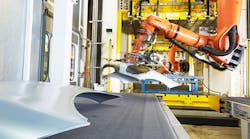The head of Magna International Inc. said that investors who have been dumping shares in North America’s second-largest auto parts maker are overlooking a burgeoning growth driver at the Canadian company — technology.
Magna stock has slumped 31% over the past 12 months to a market value of about C$19.5 billion ($14.80 billion). That’s left the company, which employs about 129,000 people in more than 300 plants from Germany to China, the most undervalued among its global peers, according to data compiled by Bloomberg.
“I think the perception is, we’re not a technology play,” Magna CEO Don Walker said. “We’re doing a lot of R&D.”
Magna has tumbled with its peers amid concerns that U.S. auto sales peaked with last year’s record deliveries. Shares have also been impacted by speculation that new rivals in China, or companies such as Tesla Motors Inc. and Google parent Alphabet Inc. are about to dethrone incumbent auto manufacturers with electric or autonomous vehicles, Walker said.
The slide has left Magna’s price-earnings ratio at 6.9 times future earnings, the lowest among the world’s 10 largest auto suppliers, according to Bloomberg data. That’s even as the Aurora, Ontario-based company has generated an average annual return on capital of 18% over the past three years, compared with the 13% average of its peers. Its profitability, or earnings before interest, taxes, depreciation and amortization, has also risen faster. Analysts forecast Magna shares will rise 28% in the next 12 months versus an 18% average for its 10 peers.
Magna also posted quarterly results that topped analysts’ estimates on Friday, with sales up 16% to $9.44 billion from a year ago and diluted earnings rising 9.3% to $1.41 a share. The company has now posted nine straight quarters of better-than-projected results. At the same time, Magna’s own technology efforts are being given short shrift, Walker said.
Magna acquired Telemotive AG, an engineering services company specializing in driver assistance, vehicle diagnostics, electronics and auto software for an undisclosed sum in April. It has five facilities and employs about 550 people, who will be integrated into Magna’s vehicle manufacturing and engineering unit, Magna Steyr in Germany.
Magna is also keeping an eye out for potential acquisitions or partnerships to bolster the firm’s electronics unit, which focuses on cameras and sensors needed in automated driving technology, Walker said.
“We could consider doing something bigger in the electronics field, maybe a partnership,” he said. “We have the balance sheet and capacity to do a big acquisition but we’re also looking at where we are in the cycle, where technology is going and the price.”
Mobility of the future could be on any number of fronts, he said. “Will it be two-wheelers, three-wheelers, drones? We typically look at cars and trucks but we have an open mind.”
The next generation of sensors and vision systems will be key components of the future, Jeff Windau, an Edward Jones & Co. analyst, said. “There are opportunities to help expand their portfolio with some M&A activity.”
One thing is certain, Magna won’t be making an entire car in the future as it doesn’t want to compete with its own customers, the CEO said. He declined to comment on whether the company is collaborating on a car with Apple Inc., which is developing self-driving technology, according to people familiar with the project. German newspaper Frankfurter Allgemeine Zeitung reported in April that Magna was working with Apple at its Steyr unit.
In any case, the auto industry isn’t about to be upended by new technologies any time soon, Walker said, with current customers remaining a big part of the company’s future. Magna generated about 51% of its 2015 revenue from General Motors Co., Fiat Chrysler Automobiles NV and Ford Motor Co., according to Magna filings.
“You look at the market cap of Tesla compared to General Motors, and it just boggles my mind,” he said, adding that Tesla is a customer. Palo Alto, California-based Tesla has a market value of about $34 billion. GM, based in Detroit, is valued at $47 billion. “It’s why I’m in manufacturing and not investing, I guess.”
The idea that large volumes of fully autonomous vehicles will be on the road in five years is “insanity,” he said. Electric vehicles will probably gain market share, though not in huge numbers. “There’s no leapfrog technology, so it’s incremental. I’d be surprised in 10 years if the production on an annualized basis of pure electric vehicles is above 5%.”
Electric vehicles made up about 0.3% of the more than 20 million vehicles sold globally in first quarter, according to Bloomberg Intelligence.
Building a car is harder than building a smartphone, Walker said. Even with the latest downturn, Magna shares have more than doubled since Walker took over as sole CEO in 2010. That compares with about a 15% gain for the benchmark S&P/TSX Composite Index.
“I can accurately say unless you’re in the industry, people have no concept of how difficult it is,” Walker said. “It’s one thing to design a vehicle, then you have to figure out the costs per part, optimize that, and how do you manufacture that? If you’ve never done it before, it’s pretty well an impossible task for someone outside the industry to make a vehicle. Unless you’re making a go-kart.”
By Matthew Winkler and Eric Lam, with assistance from Shin Pei



